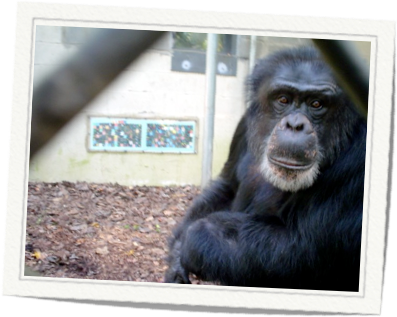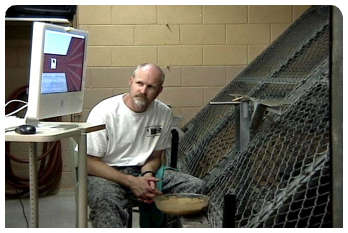
Portrait of Sherman © photo by F Dolins
VR Maze Research Synopsis
The long-term goal of the study is to characterize cognitive mapping by the great apes in simulated environments. Using Virtual Reality (VR) with humans (adults and children) and captive chimpanzees, the project examines spatial problem solving, wayfinding and landmark reliance. Performance navigating through virtual mazes of increasing difficulty and within virtual open spaces of increasing scale and size is assessed through decision-making at choice-points, path efficiency, and goal localization success. The study draws upon and extends field and laboratory studies by systematically examining how animal's spatial strategies and internal spatial representations are formed across varying spatial problems and environmental challenges (Menzel, Savage-Rumbaugh, & Menzel, 2002; Menzel, 1999; Garber & Dolins, 1996; Dolins, subm.). Virtual reality provides a controlled, flexible means to present novel environments varying in size, complexity and landmark types, and allows determination of how spatial information is utilized.
Specifically, this proposal aims to elucidate how some visual features and landmark configurations influence spatial decision-making in apes. Important questions addressed in this project are: Under what circumstances do chimpanzees perceive space as small- or large-scale? and, Do individuals respond to scale with different spatial strategies?
Testing of chimpanzees is conducted at The Language Research Center (LRC), Georgia State University (GSU) with all 4 chimpanzees housed there. These chimpanzees have been used in cognitive research over 20-30 years and are highly proficient on computer-joystick tasks; 3 are lexigram-trained (lexigrams are referential symbols relating to objects and actions (Rumbaugh & Washburn, 2003). Human testing takes place at the University of Winchester.
 Note: To ensure that no inadvertent cueing occurs the research tester typically remains at a distance of 3-5 feet from the testing apparatus/computer monitor, and only interacts with the chimpanzee to provide a food reward at the end of each successful trial. In these film clips, for filming purposes only, the technician was positioned closer to the monitor |
|---|
The program, written in C++ and OpenGL, have similar design capabilities. The experimental designer chooses the size of the virtual environment to create the smallest, least complex environment or largest, greatest navigational and path complexity (i.e., via number of t-junctions and landmarks). Designers can choose one of multiple correct routes and designate start/goal locations. There is also a choice of types, numbers, complexity of landmarks and location (e.g., 2D. 3D, photo, size, color and shapes, extra-maze, etc). 3D landmarks may include naturalistic objects (e.g., trees, boulders, etc) that are reliable over time. Auditory feedback is automatically produced when reaching the goal.
In the Virtual Maze Program, simple to complex maze tasks are presented to subjects/ participants using a series of connected t-junction units and alleyways. Similarly, the Virtual Open Space program presents increasingly complex levels of spatial and navigational tasks but without a clear perimeter and defined borders to use as additional landmarks; the navigating individual must use spatial relationships between landmark cues to localize the goal. Still pictures of the virtual environments displaying examples of the VR Maze and Open Space in their 2D format in the design process are in the 'VR Program Stills' section.
Pilot Study:
Virtual Maze. On the same or consecutive days after training, all 4 subjects were tested on two virtual mazes, first a 2t-junction (2t) (3 choice points) and then a 3t-junction (3t) (5 choice points) maze each with two different types of landmarks, positive (2D blue square on a white) and negative (2D brown triangle on white). In both mazes, positive landmarks were aligned with the correct route to the goal, while negative landmarks were associated with the incorrect route. These landmarks were located at either end of the alleyways and end of the start alleyway. Across trials, the location of the goal was randomized in two different places in the 2t maze, and in four different places in the 3t maze. Each testing session consisted of 20 trials presenting randomized (per goal location) designs of the mazes.
Maze Test Results. All 4 chimpanzees achieved criteria on the 2t maze. Latency to localize the goal was lowest for Panzee and Mercury. Measures of latency paralleled error rates: Sherman and Lana exhibited higher numbers of errors (e.g., backtracking and incorrect choices at choice points); they were less attentive to the positive and negative landmarks. Panzee exhibited one-trial learning: after the first trial, she exhibited no errors in localizing the goal. Mercury similarly made only one wrong choice in a subsequent trial. For the 3t maze test, all 4 chimpanzees explored to a greater extent in the first trial then they had done in the first trial of the previous test condition (2t). In summary, all subjects were successful in localizing the goal.
Virtual Open Space. On consecutive days after testing on the virtual mazes, all 4 chimpanzees were tested on two open space designs. The first design incorporated the same positive 2D landmark located in close spatial associated with the goal (within the same visual space). The 'goal+landmark' array was located randomly per trial in one of eight locations around the perimeter of the arena, with the start location always constant. In the second open space test design, a 3D barrier was located to occlude the view of the goal from the start position. Two positive landmarks, visible from the start position, were placed on either side of the goal (triangulated from the barrier). The 'barrier+2landmarks+goal' array was set randomly, per trial, around the perimeter of the arena in 1 of 8 locations. The chimpanzees were tested on 20 repeated trials of randomized goal location designs. On localizing the goal, positive auditory feedback occurred and a food reward was given.
Open Space Test Results. All 4 chimpanzees achieved criteria on the 8-randomized goal location open space tests. Panzee exhibited the least number and type of errors; Mercury also exhibited fewer errors than either Sherman or Lana. Errors on the first trial were typically of heading towards a landmark and actually touching the cursor to it, as if it were a goal. In contrast, in training trials and maze tests, the chimpanzees never actually touched the cursor to any landmark. Panzee, in one trial, learned to head towards the landmarks, around the barrier, and to look either right or left for the goal located behind the barrier. The other chimpanzees learned more slowly (by trial 3 or 4) to create an efficient path around the barrier; they attended to the location of one of the landmarks as an anchor towards which to head, and then veered around the barrier towards the goal. Panzee exhibited the shortest latency to localize the goal, while Mercury, Sherman and Lana required a greater amount of time, on average, over trials. In summary, all 4 the chimpanzees learned to attend to the landmarks as a guide for establishing an efficient route around the barrier to localize the goal.
Summary: In conclusion, all 4 chimpanzees performed successfully on the VR maze and open space programs, and reached criterion in both environment types of varying complexity. After one or a few trials, all 4 chimpanzees exhibited efficient navigational patterns and decreased numbers of errors to achieve the goal. They also displayed attention to the types and placement of landmarks to guide their choices in travel.
References:
Dolins, F. L. (submitted). Captive Cotton-top Tamarins (Saguinus edipus edipus) Use of Spatial Relationships Between Landmarks to Locate Hidden Food Items. Journal of Comparative Psychology.
Garber, P. A. & Dolins, F. L. (1996). Testing Learning Paradigms in the Field: Evidence for Use of Spatial and Perceptual Information and Rule-Based Foraging in Wild Moustached Tamarins. In M. A. Norconk, A. L. Rosenberger, and P. A. Garber (Eds.), Adaptive Radiations of Neotropical Primates (pp. 201-216). New York, NY: Plenum Press.
Menzel, C. R., Savage-Rumbaugh, E. S., & Menzel, E. W. (2002). Bonobo (Pan paniscus) spatial memory and communication in a 20-hectare forest. International Journal of Primatology, 23, 601-619.
Menzel, C. R. (1999). Unprompted recall and reporting of hidden objects by a chimpanzee (Pan troglodytes) after extended delays. Journal of Comparative Psychology, 113, 426-434.
Rumbaugh, D. M. & Washburn, D. A. (2003). Intelligence of Apes and Other Rational Beings. New Haven and London: Yale University Press.

.jpg)
.jpg)
.jpg)
.jpg)
.jpg)
.jpg)
.jpg)
.jpg)
.png)
.png)
.png)
